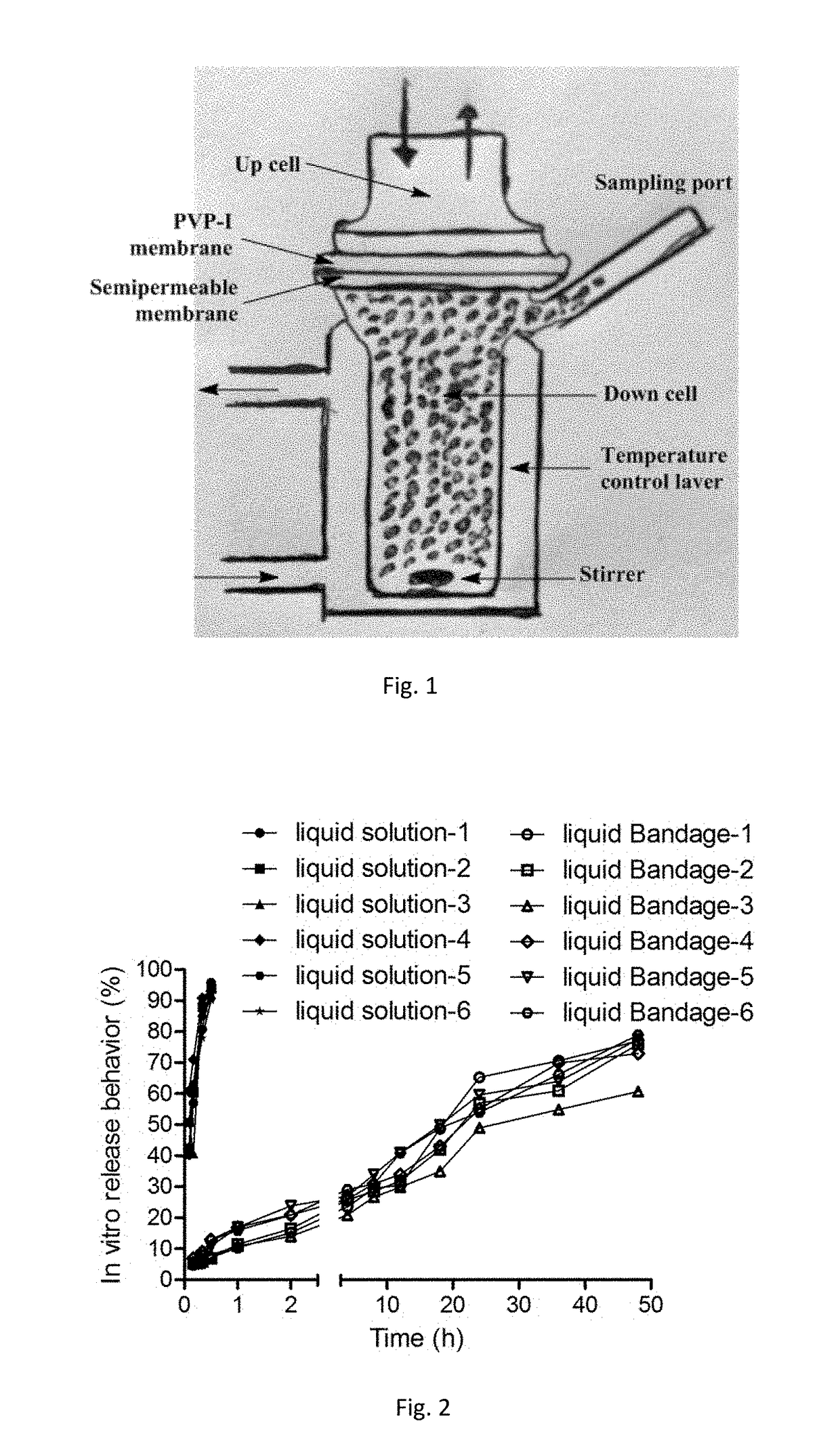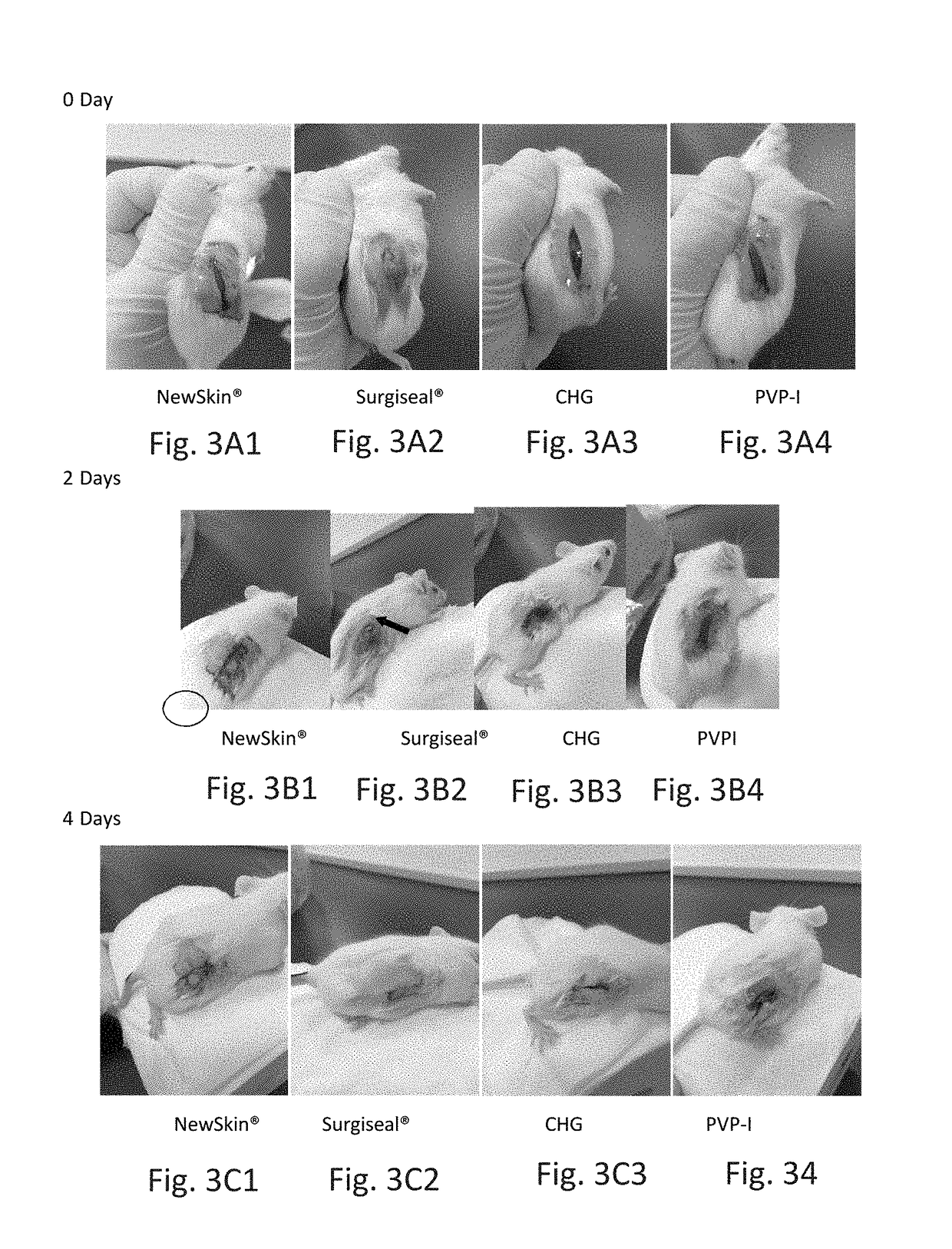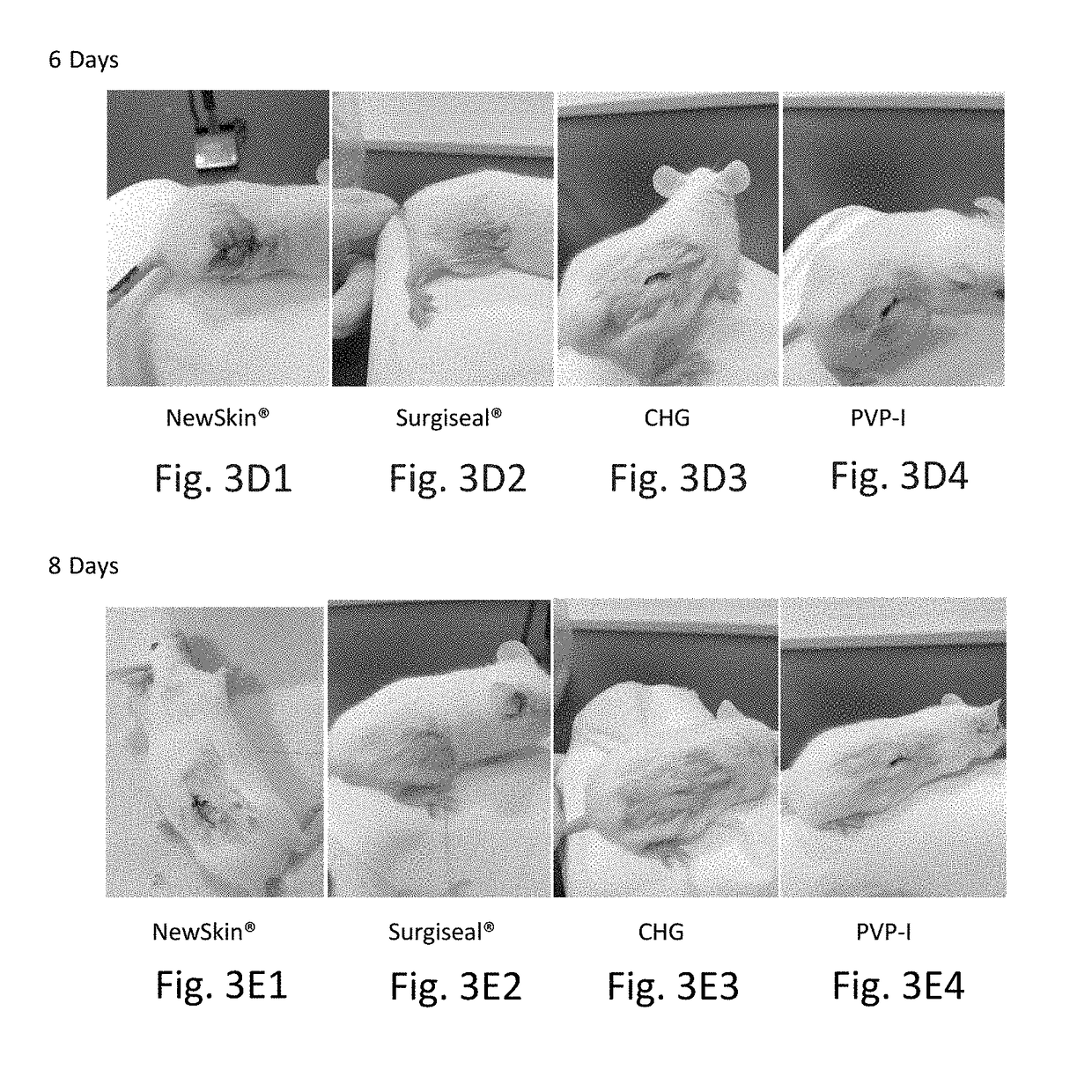Novel rapid-deposition thin-film forming compositions as effective wound care treatment
a technology of rapid deposition and composition, applied in the direction of organic active ingredients, bandages, dressings, etc., can solve the problems of poor waterproofness, poor permeability and fast curing speed of existing traditional wound dressings, and the long drying time of liquid dressings formulated with water, etc., to achieve comfort on the wound
- Summary
- Abstract
- Description
- Claims
- Application Information
AI Technical Summary
Benefits of technology
Problems solved by technology
Method used
Image
Examples
example 1
Screening of Solvent
[0039]PVP-I is a polymer complex soluble in water. To prepare a non-aqueous phase liquid dressing, the first step was to screen the solvent phase, as shown in Table 1:
TABLE 1Solubility of Povidone Iodine (PVP-I) in Different Organic SolventsSample123456789101112PVP-I0.2 g0.2 g0.2 g0.2 g0.2 g0.2 g0.2 g0.2 g0.2 g0.2 g0.2 g0.2 gEthanol4.5 g00004.5 g4.5 g4.5 g4.5 g4.5 g4.5 g4.5 gEthyl acetate04.5 g0001.5 g01.5 g1.5 g000Acetone004.5 g0001.5 g1.0 g0000Isopentane0004.5 g00001.0 g0.5 g1.0 g1.5 gn-pentane00004.5 g0000000SolubilityVeryInsolubleGoodVery GoodGoodDrying time3 Min00003 min1 min1 min1 min2 min2 min2 min27 s45 s35 s25 s37 s32 s18 sNOTE:%: the percentage of total formulation volume (W / W)
[0040]To make PVP-I liquid bandage solutions to form rapid-deposition film on skin surface, low boiling-point volatile solvents were selected to study solubility of PVP-I and the time required for the solvent to evaporate to dryness. Table 1 above shows that PVP-I was readily solu...
example 2
Pre-Formulations with Nitrocellulose as Film-Forming Material
[0041]After screening of the non-aqueous solvents, preparations of PVP-I liquid bandage pre-formulations with nitrocellulose as film-forming material were carried out as nitrocellulose has been widely used in liquid bandage products such as New Skin products. The formulation samples were left at room temperature, and their stability data were shown in Table 2:
TABLE 2Pre-formulations with nitrocellulose as film-forming materialFormulation No.59101315182123Povidone0.2 g0.2 g0.1 g0.2 g0.2 g0.2 g0.2 g0.1 giodineEthanol4.5 g4.5 g4.6 g2.5 g4.5 g6.0 g4.5 g4.5 gEthyl acetate0004.5 g3.3 g2.2 g4.0 g3.4 gAcetone2.5 g2.3 g2.3 g00000Isopentane1.5 g1.5 g1.5 g1.5 g0.5 g000Nitrocellulose1.0 g1.2 g1.2 g0.8 g1.2 g0.8 g0.5 g1.0 gCastor oil0.2 g0.2 g0.2 g00.2 g000Camphor0.1 g0000.1 g000Mint0.1 g0.1 g00000
[0042]The results in Table 2 showed that the mixture of PVP-I and nitrocellulose was not inductive for preparing a clear liquid bandage form...
example 3
Adjustment of Formulation Preparation Processes
[0043]Based on the initial screening of formulations as described in Example 2, we found that using the mixture of PVP-I and nitrocellulose to prepare a liquid bandage resulted in cloudy appearance of the prepared samples, and separation of layers was observed after samples were left at the room temperature for one week. These indicated that samples were unstable. To determine if different formulation processes could result in clear liquid bandage formulations. Shown in Table 3 below are the formulations prepared by different preparation processes:
TABLE 3Additional Liquid Bandage FormulationsFormulation No.192022Povidone iodine0.2 g0.2 g0.2 gEthanol4.5 g4.5 g1.5 gEthyl acetate3.3 g3.3 g6.0 gNitrocellulose1.0 g1.0 g1.0 gInitial ClarityTurbidTurbidTurbid
Preparation Process:
Formulation 19
[0044]2.5 g ethanol and 0.2 g PVP-I were mixed and stirred to dissolve until a clear violet solution was obtained with no insoluble substance observed. Th...
PUM
| Property | Measurement | Unit |
|---|---|---|
| Fraction | aaaaa | aaaaa |
| Fraction | aaaaa | aaaaa |
| Fraction | aaaaa | aaaaa |
Abstract
Description
Claims
Application Information
 Login to View More
Login to View More - R&D
- Intellectual Property
- Life Sciences
- Materials
- Tech Scout
- Unparalleled Data Quality
- Higher Quality Content
- 60% Fewer Hallucinations
Browse by: Latest US Patents, China's latest patents, Technical Efficacy Thesaurus, Application Domain, Technology Topic, Popular Technical Reports.
© 2025 PatSnap. All rights reserved.Legal|Privacy policy|Modern Slavery Act Transparency Statement|Sitemap|About US| Contact US: help@patsnap.com



